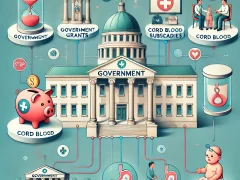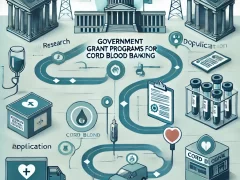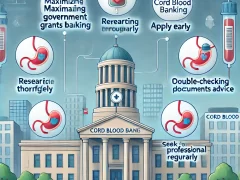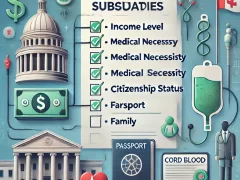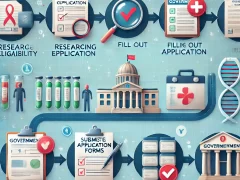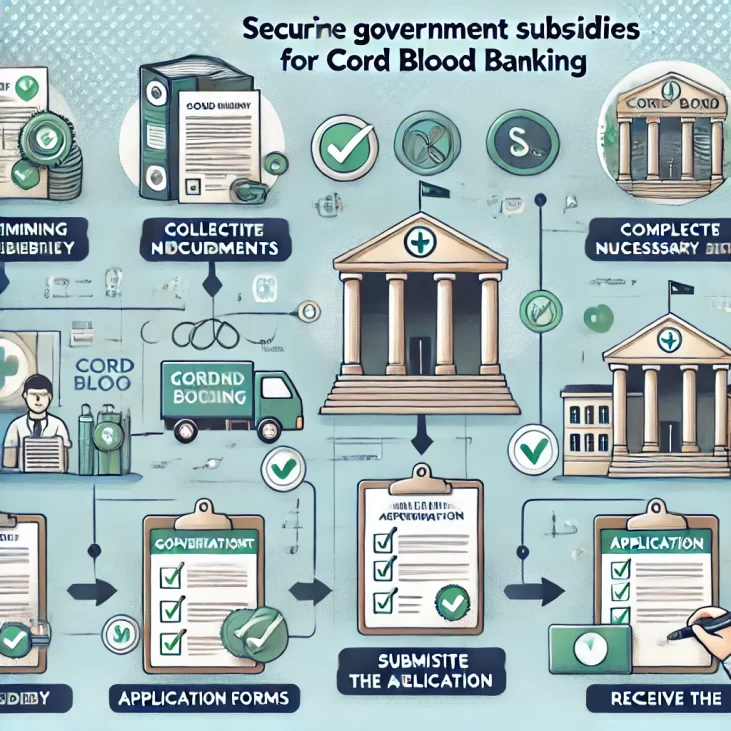
Securing Government Subsidies for Cord Blood Banking
Cord blood banking is a crucial medical procedure that has gained significant attention in recent years. As the demand for this service continues to grow, many families are seeking ways to offset the costs associated with it. One avenue of support that has emerged is government subsidies, which can provide financial assistance to those looking to preserve their child’s cord blood.
Understanding the Benefits of Cord Blood Banking
Cord blood is a rich source of stem cells, which can be used to treat a variety of medical conditions, including leukemia, lymphoma, and genetic disorders. By banking this valuable resource, families can ensure that it is available for potential future use, either for the child or for a family member in need. The benefits of cord blood banking are well-documented, and many governments have recognized the importance of making this service accessible to their citizens.
Applying for government subsidies for cord blood banking can be a complex and daunting task. Each jurisdiction has its own set of requirements and eligibility criteria, which can vary widely. In some cases, the subsidies may be available to all families, while in others, they may be limited to specific income levels or medical conditions.
To navigate this process effectively, it is essential to research the available options in your local area. This may involve contacting the relevant government agencies, healthcare providers, or cord blood banking services to understand the specific requirements and application procedures. Additionally, it is crucial to gather all the necessary documentation and submit a complete and accurate application to increase your chances of approval.
Maximizing the Impact of Government Subsidies
Once you have secured government subsidies for cord blood banking, it is important to make the most of the financial assistance. This may involve exploring ways to further reduce the overall cost of the service, such as negotiating with cord blood banking providers or exploring alternative payment options.
Additionally, it is essential to understand the terms and conditions of the subsidy program, including any restrictions or limitations on the use of the funds. By staying informed and proactive, you can ensure that you are making the most of the available resources and providing the best possible care for your child.
Staying up-to-date with Changes and Developments
The landscape of government subsidies for cord blood banking is constantly evolving, with new programs and policies being introduced on a regular basis. To ensure that you are taking advantage of the most current opportunities, it is crucial to stay informed and engaged with the relevant government agencies and healthcare providers.
This may involve regularly checking for updates on government websites, subscribing to newsletters or mailing lists, or networking with other families who have navigated the process. By staying up-to-date and proactive, you can ensure that you are taking full advantage of the available resources and securing the best possible outcome for your family.
Securing government subsidies for cord blood banking can be a complex and challenging process, but it is one that is well worth the effort. By understanding the benefits of this service, navigating the application process, maximizing the impact of the subsidies, and staying up-to-date with the latest developments, families can ensure that they are able to access this invaluable medical resource and provide the best possible care for their children.
Maximizing Funding Opportunities: Strategies for Securing Cord Blood Banking Subsidies
Cord blood banking has emerged as a valuable resource in the field of regenerative medicine, offering potential therapeutic benefits for a wide range of medical conditions. However, the cost associated with cord blood banking can be a significant barrier for many families. Fortunately, government subsidies and funding opportunities exist to help alleviate the financial burden and increase access to this valuable resource.
Identifying Eligible Programs and Initiatives
The first step in securing government subsidies for cord blood banking is to research and identify the available programs and initiatives in your region. Many countries and states offer financial assistance for families interested in preserving their child’s cord blood. These programs may be administered through government agencies, healthcare providers, or nonprofit organizations.
Key factors to consider when exploring funding options include income eligibility, residency requirements, and the specific services or costs covered by the subsidies. It’s important to thoroughly review the program guidelines and documentation to ensure your family meets the necessary criteria.
Preparing the Necessary Documentation
Once you’ve identified the appropriate funding sources, the next step is to gather and organize the required documentation. This typically includes personal identification, financial records, and details about the cord blood banking process. Ensure that all information is accurate and complete, as missing or inaccurate documentation can delay or even disqualify your application.
The application process for government subsidies can vary depending on the specific program. Some may require you to submit the application directly, while others may work in collaboration with the cord blood banking provider. Be sure to carefully review the application instructions and deadlines to ensure your submission is processed in a timely manner.
During the application process, you may be asked to provide additional information or clarification. Respond promptly and transparently to any requests, as this can help expedite the review and approval of your application.
Maximizing the Impact of Subsidies
Once your application is approved, it’s important to understand how the subsidies can be used to offset the costs of cord blood banking. Some programs may provide a direct financial contribution, while others may offer discounts or reduced fees through the cord blood banking provider.
It’s also worth exploring any additional support or resources that may be available, such as educational materials or guidance on navigating the cord blood banking process. By fully leveraging the benefits of the subsidies, you can ensure that your family has access to this valuable medical resource without the financial burden.
Staying Informed and Advocating for Expansion
The landscape of government subsidies for cord blood banking is constantly evolving, and it’s important to stay informed about any changes or new initiatives. Follow updates from relevant government agencies, healthcare providers, and cord blood banking organizations to ensure you’re aware of the latest funding opportunities.
Additionally, consider becoming an advocate for the expansion of these programs. By sharing your experiences and advocating for increased access to cord blood banking subsidies, you can help raise awareness and drive positive change in your community and beyond.
Securing government subsidies for cord blood banking can be a complex process, but the potential benefits make it a worthwhile investment. By understanding the available programs, preparing the necessary documentation, and maximizing the impact of the subsidies, families can ensure that the valuable resource of cord blood is accessible and affordable.
Compliance Considerations: Ensuring Eligibility for Government Subsidies in Cord Blood Banking
Cord blood banking has become an increasingly popular option for families looking to preserve their child’s stem cells for potential future medical use. However, the process of securing government subsidies for cord blood banking can be a complex and challenging undertaking. In this article, we will explore the compliance considerations and eligibility requirements that individuals and organizations must navigate to access these valuable financial incentives.
Understanding the Eligibility Criteria
Government subsidies for cord blood banking are typically designed to support specific target groups or demographics. To qualify for these subsidies, applicants must carefully review the eligibility criteria set forth by the relevant government agencies or programs. This may include factors such as household income, geographic location, medical history, or the intended use of the stored cord blood.
The application process for government subsidies in cord blood banking can be multifaceted and require extensive documentation. Applicants may need to provide detailed financial information, medical records, and other supporting materials to demonstrate their eligibility. Navigating the bureaucratic landscape and ensuring compliance with all the necessary requirements can be a daunting task.
Maintaining Compliance Throughout the Cord Blood Banking Journey
Securing government subsidies is just the first step in the cord blood banking process. Individuals and organizations must also maintain compliance with ongoing regulations and requirements to continue receiving the financial support. This may involve regular reporting, adherence to storage and handling protocols, and cooperation with any audits or inspections conducted by the governing authorities.
Leveraging Professional Assistance
Given the complexity of the compliance landscape, many individuals and organizations choose to seek the guidance of experienced professionals, such as legal experts or specialized consultants. These experts can provide invaluable assistance in navigating the application process, ensuring eligibility, and maintaining compliance throughout the cord blood banking journey.
The Importance of Staying Informed
The regulatory landscape for cord blood banking and government subsidies can evolve over time, with changes to eligibility criteria, application procedures, and reporting requirements. It is crucial for individuals and organizations to stay informed about the latest developments and updates to ensure they remain compliant and continue to benefit from the available financial support.
Securing government subsidies for cord blood banking can be a complex and challenging process, but the potential benefits make it a worthwhile pursuit for many families and healthcare providers. By understanding the eligibility criteria, navigating the application process, maintaining compliance, and leveraging professional assistance, individuals and organizations can maximize their chances of successfully accessing these valuable financial incentives.
The Financial Impact of Cord Blood Banking Subsidies on Healthcare Providers
Accessing Government Subsidies for Cord Blood Banking
Cord blood banking has become an increasingly important aspect of healthcare, offering numerous benefits for both patients and healthcare providers. However, the cost of setting up and maintaining a cord blood banking program can be a significant financial burden, particularly for smaller healthcare facilities. Fortunately, government subsidies are available to help offset these costs, providing an opportunity for healthcare providers to better serve their communities.
Understanding the Eligibility Requirements
To secure government subsidies for cord blood banking, healthcare providers must first understand the eligibility requirements. These vary depending on the jurisdiction, but typically include factors such as the size of the healthcare facility, the population served, and the specific services offered. It is essential to thoroughly research the available programs and their criteria to ensure that the healthcare provider meets the necessary qualifications.
Once the eligibility requirements have been determined, the next step is to navigate the application process. This can often be a complex and time-consuming task, requiring the submission of detailed documentation and adherence to strict deadlines. Healthcare providers may need to seek assistance from experienced grant writers or consultants to ensure that their application is complete and compelling.
Optimizing the Allocation of Subsidies
Even after securing government subsidies, healthcare providers must be strategic in how they allocate these funds. This may involve prioritizing certain aspects of the cord blood banking program, such as expanding storage capacity, enhancing public awareness, or improving the quality of the collected samples. By carefully planning the use of the subsidies, healthcare providers can maximize the impact of the funding and ensure that it is directed towards the areas of greatest need.
Ongoing Compliance and Reporting Requirements
Receiving government subsidies often comes with ongoing compliance and reporting requirements. Healthcare providers must be diligent in keeping accurate records, submitting required documentation, and adhering to any performance metrics or program guidelines. Failure to meet these requirements could result in the loss of funding or even penalties, so it is essential to have a robust system in place to manage these obligations.
The Financial Impact on Healthcare Providers
The financial impact of government subsidies for cord blood banking can be significant for healthcare providers. By offsetting the substantial costs associated with establishing and maintaining a cord blood banking program, these subsidies can free up resources that can be redirected towards other areas of patient care. This can lead to improved patient outcomes, increased accessibility to specialized services, and enhanced overall healthcare delivery.
Moreover, the availability of government subsidies can also encourage more healthcare providers to invest in cord blood banking, ultimately expanding the reach and accessibility of this important service. As more facilities offer cord blood banking, patients will have greater opportunities to participate, leading to a larger and more diverse pool of stored samples.
Government subsidies for cord blood banking represent a valuable opportunity for healthcare providers to enhance their service offerings and better serve their communities. By navigating the eligibility requirements, optimizing the allocation of funds, and maintaining compliance, healthcare providers can unlock the financial and operational benefits of these subsidies, ultimately leading to improved patient care and outcomes.
Leveraging Advocacy and Partnerships to Enhance Cord Blood Banking Subsidy Access
Securing Government Subsidies for Cord Blood Banking
Navigating the complex landscape of government subsidies for cord blood banking can be a daunting task, but with the right strategies and partnerships, organizations can significantly enhance their access to these vital resources. In this article, we’ll explore the process of securing government subsidies and the role of advocacy and strategic collaborations in driving success.
Identifying Eligible Programs and Requirements
The first step in securing government subsidies for cord blood banking is to thoroughly research and identify the available programs. This may involve exploring federal, state, and local initiatives that offer financial support for cord blood collection, storage, and research. Understanding the eligibility criteria, application processes, and deadlines is crucial to ensuring your organization’s success in securing the necessary funding.
Engaging in Targeted Advocacy Efforts
Advocacy plays a pivotal role in enhancing access to government subsidies for cord blood banking. By leveraging the collective voice of industry stakeholders, including healthcare providers, researchers, and patient advocates, organizations can effectively communicate the importance and societal benefits of cord blood banking. This advocacy approach can involve lobbying policymakers, participating in public hearings, and collaborating with industry associations to shape the legislative and regulatory landscape in favor of increased funding opportunities.
Fostering Strategic Partnerships
Forming strategic partnerships with key stakeholders can significantly bolster an organization’s chances of securing government subsidies. This may involve collaborating with research institutions, healthcare providers, and patient advocacy groups to demonstrate the far-reaching impact of cord blood banking. By aligning with respected partners and highlighting the collective value proposition, organizations can build a stronger case for securing government funding.
The application process for government subsidies can be complex, with detailed requirements and specific documentation needed. Successful organizations often dedicate specialized resources to thoroughly understand and meticulously complete the necessary paperwork. This may involve consulting with legal experts, financial advisors, and grant-writing professionals to ensure compliance and maximize the chances of a successful application.
Demonstrating Positive Outcomes and Impact
Once the funding has been secured, it’s essential for organizations to continually demonstrate the positive outcomes and impact of their cord blood banking initiatives. This may involve tracking key performance indicators, such as the number of samples collected, the utilization of stored samples for research and clinical applications, and the tangible benefits to patients and communities. By consistently communicating these successes, organizations can strengthen their case for ongoing or increased government support.
Fostering Collaborative Ecosystems
The most successful cord blood banking organizations often cultivate a collaborative ecosystem involving various stakeholders, including government agencies, research institutions, healthcare providers, and patient advocacy groups. By fostering open communication, knowledge sharing, and joint initiatives, these organizations can collectively advocate for and secure government subsidies, ultimately enhancing the accessibility and impact of cord blood banking for the benefit of all.
Securing government subsidies for cord blood banking requires a multi-faceted approach that leverages advocacy, strategic partnerships, and a deep understanding of the application process. By proactively engaging with policymakers, aligning with key stakeholders, and demonstrating the positive outcomes of their initiatives, organizations can significantly increase their chances of accessing the vital resources needed to drive the growth and impact of cord blood banking.
Conclusion
Securing government subsidies for cord blood banking is a complex and multifaceted process that requires a strategic and comprehensive approach. By navigating the intricate landscape of available funding opportunities, maximizing eligibility, and leveraging advocacy efforts, healthcare providers can unlock the financial benefits that these subsidies offer.
One of the key factors in successfully securing cord blood banking subsidies is a deep understanding of the eligibility criteria and compliance requirements. Healthcare providers must carefully navigate the nuanced guidelines set forth by government agencies, ensuring that their operations and practices align with the necessary standards. This may involve investing in specialized training, implementing rigorous quality control measures, and maintaining meticulous documentation to demonstrate adherence to the regulations.
In addition to compliance considerations, healthcare providers must also be well-versed in the diverse range of funding options available for cord blood banking. From targeted grants and tax incentives to reimbursement programs, the landscape of government subsidies can be overwhelming. By proactively researching and identifying the most relevant funding sources, healthcare providers can maximize their chances of securing the necessary financial support to sustain and expand their cord blood banking initiatives.
Moreover, the strategic utilization of advocacy and partnerships can further enhance a healthcare provider’s ability to access cord blood banking subsidies. By collaborating with industry associations, lobbying groups, and policymakers, providers can amplify their voices and advocate for the recognition and prioritization of cord blood banking within the healthcare ecosystem. These partnerships can also facilitate the sharing of best practices, the dissemination of educational resources, and the development of tailored strategies to navigate the evolving regulatory landscape.
The financial impact of cord blood banking subsidies cannot be overstated. By securing government support, healthcare providers can alleviate the financial burden associated with the establishment and maintenance of cord blood banking programs. This, in turn, can lead to increased accessibility and affordability for patients, ultimately improving the overall viability and sustainability of these critical healthcare services.
The process of securing government subsidies for cord blood banking requires a comprehensive and strategic approach. By navigating the complex landscape of available funding opportunities, ensuring compliance with regulatory requirements, and leveraging advocacy and partnerships, healthcare providers can unlock the financial benefits that these subsidies offer. This, in turn, can lead to the enhanced accessibility and sustainability of cord blood banking services, ultimately benefiting patients and the broader healthcare ecosystem.

